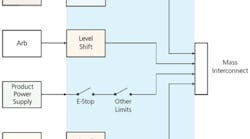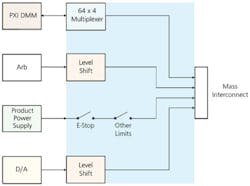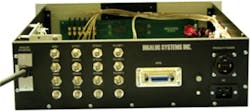Price competition is more evident in automotive electronics than in any other industry. To remain competitive, new cost-effective technologies must be implemented in the design and manufacture of automotive electronic products. As a result, automotive electronics testing must be equally responsive by applying new test and measurement methodologies that accurately and quickly accommodate validation and functional testing.
Technology advances continue to accelerate improvements in product performance and cost. Test-solutions providers compete to use these advances to match technology to specific test scenarios.
The competition among test-solution providers typically is not won through the selection of test tools. Rather, it is won through innovations in quickly adapting diverse test tools to the products under test while accommodating all application-specific requirements.
The physical adaptation of test tools to the DUT can be defined as a resource gateway (Figure 1). This definition ranges from a single cable to a functional, integrated fixture capable of handling self-diagnostics and calibration routines.
Figure 1. Block Diagram of Resource Gateway
Basic Resource Gateway
In its most simplistic form, a resource gateway may be defined as a cable that connects the resources of the test system to the DUT. Because the presentation of resources is fixed, the interface to this cable can be designed to accommodate other equipment and fixtures.
One example was the requirement to test several variations of a low-power, single-protocol, low pin-count automotive module. This module had slight hardware variations in functionality depending on customer requirements. With the superset of resources available at the end of an umbilical cable, the fixture and wire costs were kept to a minimum while allowing a production changeover time of less than one minute.
Cross-Point Matrix
Additional equipment savings may be realized by moving simple functionality from a relatively more expensive chassis into the resource gateway. An example of this concept is the Digalog DigESwitch. Like other instruments controlled via Ethernet, the DigESwitch is not tethered to a backplane or even an equipment rack.
In one application, this 230 � 8 cross-point switch was used by a major automotive manufacturer to distribute stimulus and measurement functions to high pin-count devices. This option can be appealing when test-system capability becomes limited by the amount of open PCI, PXI, or VXI slots.
For light-duty loading, measurement, and stimulus, the cross-point method can be cost-competitive for low-power, high pin-count applications. First, the cross-point switch interface becomes a standard interface. Second, all connections in the fixture are designed as one-to-one routing. Finally, if there is a pin-out modification, the fixture does not need to be changed.
In one application where the test equipment is 10 feet away from the DUT, relocating the cross-point switch provided significant cabling savings and reduced system noise. By locating the cross-point switch close to the DUT, 200 conductors were routed 2 feet while only 15 shielded conductors had to extend the full 10 feet to the test equipment.
Integrated Resource Gateway
Standardizing on a resource gateway is another step toward increased capability and potential equipment savings. This level of functionality allows the incorporation of specific items or requirements that are not available within standard architectures. Typically, this type of implementation uses an interface such as GPIB, USB, or Ethernet for control over configuration or functionality (Figure 2).
Figure 2. Integrated Tester Component
When designing-in a custom requirement, it is important that sound engineering practices are used to ensure a maintainable, reproducible, and stable product. To provide a standard, reusable interface, a mass-interconnect usually is needed. Within the resource gateway, it also is possible to interrupt or modify the signal path or add customization not available or economical within the tester architecture.
In one case, a test solution needed to protect proprietary telemetry technology. The test-solution provider could not access the wireless transfer protocol because the transmitters and signal routing were simply added to the resource gateway as system components.
It also can be very profitable for the manufacturer to incorporate self-diagnostics capabilities in the resource gateway. Self-diagnostics in the resource gateway help keep mean time to repair to a minimum. This becomes important when deploying multiple test systems in remote facilities. Self-diagnostics routines allow people of different nationalities and technical skills to provide live feedback to the manufacturer with minimal risk of misinterpretation.
The concept of automated self-diagnostics can be taken one step further to include equipment calibration capabilities. A simple utility and minimal resident hardware may be incorporated in the resource gateway that enables the transfer of standards from NIST to the test equipment. When the self-diagnostics routines are executed, the components are tested to the resident standards. The greatest return on this type of investment is again realized where multiple systems are deployed.
Yet another implementation in the resource gateway provided a means to standardize on safety considerations. In one instance, completed test systems had to be redesigned to satisfy safety requirements. As a result, a solution was developed that handled ground faults, emergency stops, light curtains, warning lights, and lockouts.
When testing power-hungry automotive devices such as power door locks, power windows, seat heaters, and seat motor controls, heavy currents cause the conductor size to grow considerably to keep voltage drops within specified limits. Compensating for the wire resistance and various contact resistances is difficult to standardize or reproduce. By moving these switched components to be as close as possible to the DUTs controlling them, cabling size and costs can be kept to a minimum.
Fixture
In one challenging automotive application, it was necessary to provide a vision system consisting of several cameras and testing capabilities for RF communications. The vision system verified product markings before the DUTs were mechanically encased in a tight Faraday cage. The fixture allowed very sensitive impedance matching networks to be placed within 1 cm of the point of contact. Along with the matching networks, a signal conditioner also was incorporated in the input to a network analyzer.
Embedded Test System
In the form of an embedded system, the resource gateway actually takes on the responsibility for most or all test instrumentation. This approach has been developed in instances where many test systems are needed for a specific set of conditions.
Transducers convert a physical property to a voltage or time measurement. The standardization of these types of measurements through custom embedded systems can reduce duplicate test-system costs.
Transducer Electronics Data Sheet (TEDS) technology is one such case. A TEDS stores the transducer capabilities and supports a defined protocol to interrogate them.
In another case, a single-board system can control high-current switching such as product power and high-current loading. However, careful consideration must be given to thermal management and safety considerations.
Hybrid
To create the most cost-effective solution, consider parameters such as test requirements, available test tools, deployment and maintenance strategy, life cycle, and test time vs. cost. The different values attributed to these parameters will dictate which approach or combination of approaches offers the greatest potential of return on investment.
The hybrid approach is the most typical application of tester resources to DUTs within the automotive electronics test industry. For example, small-signal measurements and stimuli may be handled with PXI architecture while multiplexing is handled with LXI, power sourcing with GPIB, and protocol conversion with USB. This is all brought together and offered in standardized fixtures, handlers, or umbilical interfaces.
This approach also is being used in markets such as ASIC test. For example, when the ASIC has to drive a load located within millimeters of the device, it is very difficult to apply a cost-effective, off-the-shelf solution. However, it is not so difficult if a standard architecture is interfaced to the ASIC via a resource gateway that also incorporates the physical proximity of the precise loading requirements.
Summary
Test equipment requirements to accommodate the many automotive electronics products have grown to include arbitrary waveform generators, digitizers, network analyzers, vision tools, protocol tools, programmable loads, and high-current DC power distribution. To stay cost-competitive while meeting these diverse requirements typically requires the use of mixed architectures.
By embracing the concept of a resource gateway, time and money can be saved, and risks can be minimized. A resource gateway in the form of a cable, switch matrix, integrated component, fixture, or embedded system can be the most powerful tool to bridge the gap between instruments and the DUTs.
About the Author
Patrick Beaver is the engineering manager at Digalog Systems. He has been involved with electronics test engineering for 16 years, starting by designing and developing instruments for the company�s test system architectures. Mr. Beaver also has been architecting and producing custom test solutions for eight years and directing COTS test tool development for three years. Digalog Systems, 3180 S. 166th St., New Berlin, WI 53151, 262-797-8000, e-mail: [email protected]
March 2007



